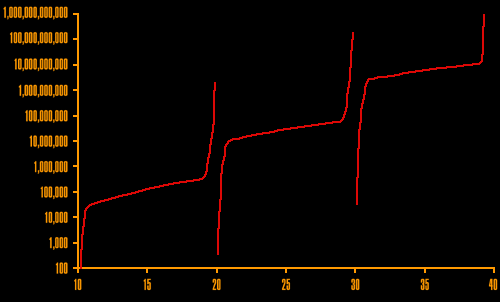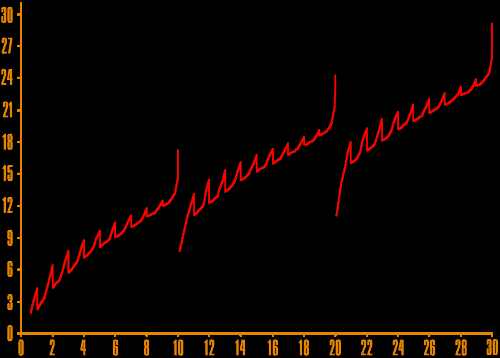Canon Facts Backstage Info Speculation
Unfortunately, while the Excelsior's non propulsion systems where a success, the transwarp project itself proved to be over-ambitious. Launched in 2285, it was only a deliberate act of sabotage by the Chief Engineer which prevented a catastrophic nacelle implosion on the first flight. Despite years of further work on the engines, the Excelsior was branded a failure - never made a successful test flight, and never having broke the transwarp barrier. Starfleet abandoned the Excelsior transwarp project altogether in 2287 and refitted the ship with a standard warp drive.
This was not the end for Federation transwarp technology, however. In 2372 the crew of the USS Voyager succeeded in conducting two brief shuttlecraft flights at warp 10 - actually straddling the warp barrier itself, and achieving infinite speed! However, several significant problems remain with this approach; Voyager crew members who conducted the flight experienced severe health problems, including genetic abnormalities. Voyager relayed some details of this flight back to Starfleet in 2373 via an alien subspace communications array; experts analysing the technology have indicated that the difficulties experienced by Voyager are in fact only the tip of the iceberg. As well as the guaranteed genetic damage, the subspace fields associated with this form of transwarp drive results in an 85% chance of fatality per flight. Significant problems also remain with navigating a vessel using this form of drive system, and as a result even unmanned probes have proved to be unusable.
The crew of the USS Voyager, who had tested their own transwarp drive in 2372, encountered a transwarp-capable species known as the Voth while journeying in the Delta Quadrant. A typical Voth ship was capable of some 200,000 times light speed using their transwarp drives. Voyager has subsequently encountered the Borg, and has confirmed that standard Borg cubes are capable of using a form of the transwarp conduit used by the experimental vessel under Lore's control. This drive is apparently much slower than Lore's vessel, a technology which the Borg seem to have abandoned after the loss of the prototype.
In 2269, scientists working for the Daystrom Institute took the theoretical models of subspace created by Terrance and Neltorr one step further. It was realized that the mathematics allowed for a second subspace region stretching from the warp 10 barrier up to another, similar barrier at warp 20 - a region which a public relations officer in the Daystrom Institute press office dubbed the "transwarp domain", a name which has stuck despite its inaccuracy.
In 2270 it was realized that even this theoretical transwarp domain was only part of the whole structure. The theory allowed for an infinite number of such domains, each separated by a warp barrier. Throughout the early 2270's there was a huge effort to discover whether these transwarp domains where just theoretical constructs, or where actually real. In 2273 the Starfleet science vessel USS Wanderer conducted a subspace particle dissipation experiment which proved conclusively that not only did transwarp domains actually exist, but that under certain circumstances it was possible for matter to circumvent the warp barrier and pass into the transwarp domain.
Theoretical and practical studies quickly established that at a point infinitesimally past Warp 10, the warp factor exponent fell from infinity to zero and then began to gradually rise again. By Warp 11 the exponent reached 13/3, after which it mirrors the behaviour of the normal warp curve. A Warp 19 the exponent begins to climb, again reaching infinity at warp 20 to form the next warp barrier. The whole process is repeated again in the second transwarp domain, and again in the third, and so on. In each domain the 'steady' central value of the exponent increases linearly - from 10/3 in the warp domain to 13/3 in the first transwarp domain, 16/3 in the second, then 19/3, 22/3, and so on.
The speeds of warp factors within the warp domain and the first two transwarp domains can be seen on following chart.
 |
|
|
|
| TIME TO TRAVEL | |||||
| Transwarp
Factor |
Equals
(xc) |
To nearby star
(5 ly) |
Across Sector
(20 ly) |
Across Federation
(8,000 ly) |
To Andromeda
(2 million ly) |
| 11 | 32,561 | 1.3 hours | 5.4 hours | 89.7 days | 136.6 years |
| 12 | 47,474 | 55.4 mins | 3.7 hours | 61.6 days | 42.1 years |
| 13 | 67,156 | 39.2 mins | 2.6 hours | 43.5 days | 29.8 years |
| 14 | 92,588 | 28.4 mins | 1.9 hours | 31.6 days | 21.6 years |
| 15 | 124,852 | 21.1 mins | 1.4 hours | 23.4 days | 16.0 years |
| 16 | 165,140 | 15.9 mins | 1.1 hours | 17.7 days | 12.1 years |
| 17 | 214,756 | 12.2 mins | 49.0 mins | 13.6 days | 9.3 years |
| 18 | 275,115 | 9.6 mins | 38.2 mins | 10.6 days | 7.3 years |
| 19 | 347,749 | 7.6 mins | 30.2 mins | 8.4 days | 5.8 years |
| 20 | Infinite | An object at warp 20 travels at infinite speed, occupying all points in the universe simultaneously | |||
| 21 | 11,267,725 | 14.0 secs | 56.0 secs | 6.2 hours | 64.8 days |
| 22 | 14,440,680 | 10.9 secs | 43.7 secs | 4.9 hours | 50.6 days |
| 23 | 18,304,103 | 8.6 secs | 34.5 secs | 3.8 hours | 39.9 days |
| 24 | 22,968,182 | 6.9 secs | 27.5 secs | 3.1 hours | 31.8 days |
| 25 | 28,554,861 | 5.5 secs | 22.1 secs | 2.5 hours | 25.6 days |
| 26 | 35,198,530 | 4.5 secs | 17.9 secs | 2.0 hours | 20.8 days |
| 27 | 43,046,721 | 3.7 secs | 14.7 secs | 1.6 hours | 17.0 days |
| 28 | 52,260,814 | 3.0 secs | 12.1 secs | 1.3 hours | 14.0 days |
| 29 | 63,016,748 | 2.5 secs | 10.0 secs | 1.1 hours | 11.6 days |
| 30 | Infinite | An object at warp 30 travels at infinite speed, occupying all points in the universe simultaneously | |||
| 31 | 2.79 x 109 | 56.6 msec | 226.4 msec | 1.5 mins | 6.3 hours |
| 32 | 3.41 x 109 | 46.3 msec | 185.1 msec | 1.2 mins | 5.1 hours |
| 33 | 4.14 x 109 | 38.1 msec | 152.4 msec | 1.0 mins | 4.2 hours |
| 34 | 5.00 x 109 | 31.5 msec | 126.1 msec | 50.4 secs | 3.5 hours |
| 35 | 6.01 x 109 | 26.2 msec | 105.0 msec | 42.0 secs | 2.9 hours |
| 36 | 7.19 x 109 | 22.0 msec | 87.8 msec | 35.1 secs | 2.4 hours |
| 37 | 8.55 x 109 | 18.5 msec | 73.8 msec | 29.5 secs | 2.1 hours |
| 38 | 1.01 x 1010 | 15.6 msec | 62.4 msec | 24.9 secs | 1.7 hours |
| 39 | 1.19 x 1010 | 13.2 msec | 52.9 msec | 21.2 secs | 1.5 hours |
| 40 | Infinite | An object at warp 40 travels at infinite speed, occupying all points in the universe simultaneously | |||
The power required to hold a given warp factor is generally given in
Megajoules per Cochrane per second. Within the warp domain the power requirements
follow a saw-toothed curve, rising towards infinity at warp 10. Once into
the first transwarp domain the basic shape of this curve repeats itself,
although it is shifted upwards relative to the first by the higher energy
requirements involved in transwarp drive. In general, transwarp factors
require much higher engine power to maintain than the equivalent warp factor
- for example holding Warp 13 requires 50,000 times as much power as holding
Warp 3 does. But in terms of the power required to hold a specific speed,
transwarp is far more efficient. The power needed to hold Warp 13 with
a transwarp drive could maintain Warp 9.82 with standard warp drive, but
while Warp 9.82 equates to 2,530 times light speed, Warp 13 is 67,156 times
light speed - an increase in speed of almost 2654%. The following chart
shows the total power which would be needed for a galaxy class starship
to maintain a given warp or transwarp factor.
|
|
|
 |
|
|
|
|
Today a workable, practical transwarp drive remains beyond the reach of Federation science and although some efforts to develop this technology are still being made, no progress has yet been achieved.
Star Trek et al is Copyright Paramount Pictures 1996/97.
No Copyright infringement is intended and this page is for personal
use only.
All of the above classes of star ships and all of the
named ships are copyright Paramount 1996/97.